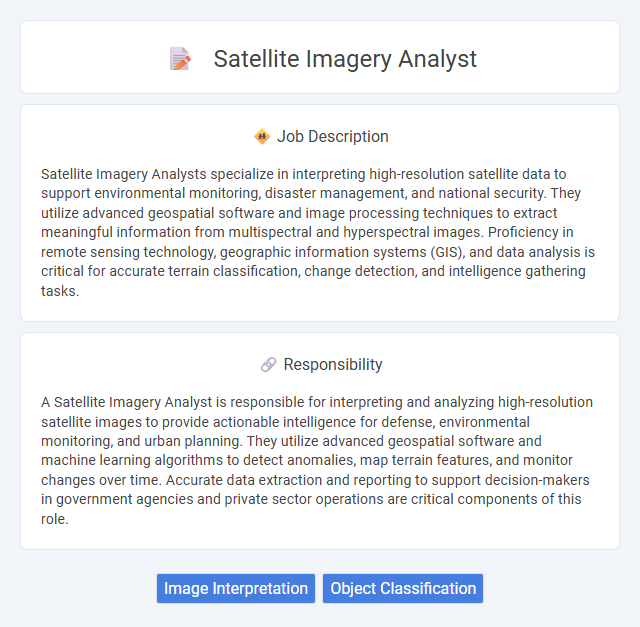
Satellite Imagery Analysts specialize in interpreting high-resolution satellite data to support environmental monitoring, disaster management, and national security. They utilize advanced geospatial software and image processing techniques to extract meaningful information from multispectral and hyperspectral images. Proficiency in remote sensing technology, geographic information systems (GIS), and data analysis is critical for accurate terrain classification, change detection, and intelligence gathering tasks.
Individuals with strong analytical skills and attention to detail are likely suitable for a Satellite Imagery Analyst position, as the job requires interpreting complex visual data. Those comfortable working with technology and remote sensing tools have a higher probability of success in this role. People who prefer solitary work and enjoy problem-solving may find this career path fitting and rewarding.
Qualification
A Satellite Imagery Analyst requires expertise in geospatial analysis, remote sensing technology, and proficiency with GIS software such as ArcGIS and ENVI. Strong analytical skills in image interpretation, data extraction, and pattern recognition are essential, alongside a background in geography, environmental science, or related fields. Experience with coding languages like Python or MATLAB for data processing enhances performance in this role.
Responsibility
A Satellite Imagery Analyst is responsible for interpreting and analyzing high-resolution satellite images to provide actionable intelligence for defense, environmental monitoring, and urban planning. They utilize advanced geospatial software and machine learning algorithms to detect anomalies, map terrain features, and monitor changes over time. Accurate data extraction and reporting to support decision-makers in government agencies and private sector operations are critical components of this role.
Benefit
A Satellite Imagery Analyst is likely to benefit from access to cutting-edge geospatial technologies and vast datasets, enhancing analytical precision and decision-making capabilities. The role probably offers opportunities for collaboration with defense, environmental, and intelligence agencies, contributing to critical mission outcomes. Career growth in this field may be supported by the increasing reliance on satellite data for security, disaster response, and resource management.
Challenge
The role of a Satellite Imagery Analyst likely involves interpreting complex geospatial data, which can present challenges such as distinguishing subtle features and patterns in varying resolutions. Analysts probably face the difficulty of managing large volumes of data while ensuring timely and accurate insights. There is a high probability that adapting to rapidly evolving satellite technologies and software tools requires continuous learning and flexibility.
Career Advancement
Satellite Imagery Analysts use advanced geospatial technologies to interpret and analyze data for defense, environmental monitoring, and urban planning sectors. Expertise in remote sensing and Geographic Information Systems (GIS) opens pathways to senior analyst roles, project management, or specialization in machine learning applications for image interpretation. Continuous skill enhancement in AI-driven analysis and cross-disciplinary collaboration drives career progression in this rapidly evolving field.
Key Terms
Image Interpretation
Satellite Imagery Analysts specialize in image interpretation to extract critical geospatial intelligence from high-resolution satellite data. They apply advanced techniques such as spectral analysis, pattern recognition, and machine learning algorithms to identify land use changes, monitor environmental conditions, and assess security threats. Proficiency in Geographic Information Systems (GIS) and remote sensing software enhances accuracy and efficiency in transforming raw satellite imagery into actionable insights.
Object Classification
A Satellite Imagery Analyst specializing in Object Classification leverages advanced machine learning algorithms and remote sensing techniques to accurately identify and categorize objects such as vehicles, buildings, and natural features within high-resolution satellite images. Proficiency in GIS software, Python scripting, and convolutional neural networks enhances the analyst's ability to process large datasets for military, environmental, and urban planning applications. Expertise in spectral analysis and pattern recognition ensures precise differentiation between various land cover types and man-made structures, optimizing decision-making in intelligence and disaster response operations.
 kuljobs.com
kuljobs.com